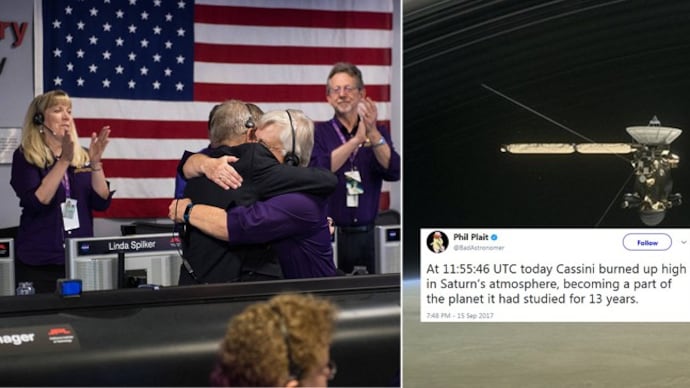Farewell, Cassini: Death of NASA spacecraft after crashing into Saturn left the world in tears
Today, the Saturn mission which went on for 13 years met its end after NASA's Cassini crashed into Saturn. Goodbye Cassini.

The world made farewell to NASA's probe Cassini which crashed into the Saturn becoming one with the planet today.
The Cassini spacecraft had a dramatic departure from Saturn's orbit and even ensured that Saturn's moons remain unharmed by debris.
"What a way to go," said Earl Maize, Cassini project manager at JPL. "Truly a blaze of glory."
The 13-year Saturn mission ended today on September 15, 2017. NASA received a final signal from Cassini as the spacecraft crashed into Saturn.
Cassini was the first spacecraft to orbit Saturn. It entered the gaseous Saturn's atmosphere at 7.55 a.m. EDT (1155 GMT) at about 1,13,000 km per hour, the National Aeronautics and Space Administration said.
"This morning a lone explorer - a machine made by human-kind - finished its mission 900 million miles away," Cassini project manager Earl Maize said at a news conference on Friday at NASA's Jet Propulsion Laboratory in Pasadena, California.
"We believe we got every last second of data."
"It's a bittersweet, but fond, farewell to a mission that leaves behind an incredible wealth of discoveries that have changed our view of Saturn and our solar system, and will continue to shape future missions and research," said Michael Watkins, director of NASA's Jet Propulsion Laboratory (JPL) in Pasadena, California, which manages the Cassini mission for the agency.
Cassini burnt up and disintegrated like a meteor.
The world came together to say their goodbyes to NASA's Cassini which was launched in October 1997 by NASA in collaboration with with the European Space Agency.
Bill Clinton tweeted, "Farewell @CassiniSaturn. Twenty years since you launched, and you've brought us a universe of understanding."
At 11:55:46 UTC today Cassini burned up high in Saturn's atmosphere, becoming a part of the planet it had studied for 13 years.- Phil Plait (@BadAstronomer) September 15, 2017
Famous astrophysicist Neil deGrasse Tyson also tweeted.
Farewell Cassini, how far you've come. On this eve, in fiery death, Saturn & you are one. VIP (Vaporize In Peace): 2004-2017 pic.twitter.com/O0yff5bo7z- Neil deGrasse Tyson (@neiltyson) September 15, 2017
An infrared image showed the impact site of Cassini.
Where did @CassiniSaturn make its final plunge? This infrared view shows the spot in the atmosphere of the planet: https://t.co/KPNcuubRbO pic.twitter.com/2m5ZfiXKG6- NASA (@NASA) September 15, 2017
"Things never will be quite the same for those of us on the Cassini team now that the spacecraft is no longer flying," said Linda Spilker, Cassini project scientist at JPL. "But, we take comfort knowing that every time we look up at Saturn in the night sky, part of Cassini will be there, too."
Impact site: Cassini's final image

The above monochrome view is the last image taken by the imaging cameras on NASA's Cassini spacecraft. It looks towards the planet's night side, lit by reflected light from the rings.
KNOW CASSINI A BIT
Cassini was launched in October 1997 by NASA in collaboration with with the European Space Agency. It was launched from Cape Canaveral, Florida, US.
The Cassini spacecraft which crashed into Saturn's environment was named after the 17th-century astronomer Giovanni Cassini.
The 20-year-old spacecraft was made when Harry Potter wasn't even published in the United States.
Over its last 13 years in orbit, spacecraft Cassini had an amazing run exploring and studying Saturn and its moons.
Cassini was revolving around Saturn's hazy moon Titan and recently, it even had its close brush with Titan.
When Cassini and Huygens explored Titan, it revealed many interesting earth-like geographic features.
It discovered great lakes of liquid gas on the moon's surface. The liquid gas can outweigh all the oil and gas reserves on mother earth.
Cassini also found evidence of an underground ocean on Saturn's sixth largest moon - Enceladus.
Earlier in April, NASA announced that Cassini had found more evidence that the ocean underneath Enceladus could contains life.
Engineers at NASA's Jet Propulsion Laboratory in Pasadena, California, awaited the final transmission from the Cassini spacecraft as it plunged into Saturn's atmosphere ending its 20-year voyage of discovery.
Watch: Final moments in Cassini Mission Control
